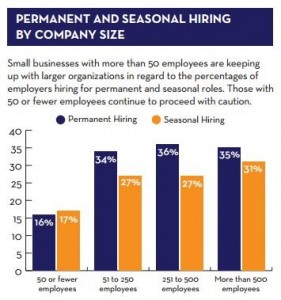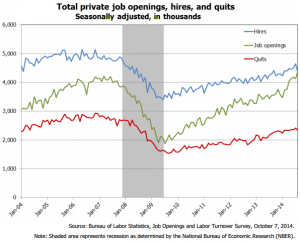 In what could be the strongest finish since before the recession, an increasing number of employers say they intend to hire full-time permanent workers this quarter.
In what could be the strongest finish since before the recession, an increasing number of employers say they intend to hire full-time permanent workers this quarter.
CareerBuilder’s quarterly survey of employers found 29 percent of them expect to add permanent headcount before the end of 2014, an increase of four percentage points over those saying that last year.
While hiring expectations don’t necessarily translate into action, so far this year more employers have ended up hiring more than what they told CareerBuilder they planned.
The survey doesn’t say how large the headcount will grow, but numbers from the Bureau of Labor Statistics show 2014 is on track to add more workers to the nation’s payrolls than at any time in a decade. Since January, employers have averaged 227,000 new jobs each month. For the same period last year, the average was 193,000.

As the number of new jobs grows, the pool of available workers is shrinking. The labor force participation rate — workers currently employed or who are actively looking for work — is now at the lowest level since 1978. Meanwhile, the ranks of the unemployed have also been shrinking. From a high of almost 7 une mployed for every job openings in mid-2009, there’s now 1.8 unemployed for each opening.
mployed for every job openings in mid-2009, there’s now 1.8 unemployed for each opening.
And those unemployed are not distributed evenly. Among those who dropped out of high school, the unemployment rate is 8.4 percent. For college graduates, the rate is 2.9 percent and dropping.
Making recruiting even more difficult is the still tentative willingness of many workers to change jobs. The Bureau of Labor Statistics says job openings (as of August, the most recent month available) hit 4.4 million, the level seen before the recession. However, the number of workers quitting their job was 2.3 million, still significantly below the pre-recession rate.
 No wonder then, that the Society for Human Resource Management says recruiting difficulty has risen every month since March. A forthcoming SHRM report will show “50 percent of organizations have had difficulty recruiting for key positions in the past 12 months, as have 60 percent of manufacturers.”
No wonder then, that the Society for Human Resource Management says recruiting difficulty has risen every month since March. A forthcoming SHRM report will show “50 percent of organizations have had difficulty recruiting for key positions in the past 12 months, as have 60 percent of manufacturers.”
This month shows every sign of becoming the eight consecutive month SHRM’s “Recruiting Difficulty” measures will rise. Its LINE prediction is that a net of 45.4 percent of manufacturers will add jobs, while a net of 40.7 percent of service-sector companies will do the same.
Adding even more pressure is the season hiring surge, which is now underway. CareerBuilder says 26 percent of employers will add temporary staff for the holiday season; 43 percent of retailers plan to hire seasonals, which could result in the biggest staffing surge since 1999.
Challenger, Gray & Christmas, the global outplacement firm, says it expects the retail industry alone could hire 800,000 or more temporary workers.
“The last two years saw holiday hiring return to pre-recession levels. This year, we could see hiring return to levels not seen since the height of the dot.com boom,” says company CEO John A. Challenger.
Here’s a look at the announced hiring plans by some of the largest companies:
- Wal-Mart will hire 60,000, a 10 percent increase;
- Target’s bringing on 70,000, about the same as last year, but existing workers may get extra hours;
- Kohl’s announce plans to add 67,000;
- Macy’s is looking at 86,000;
- Toys ‘R’ Us is estimating 45,000.
Support services such as UPS and FedEx, which announced plans to hire a combined 140,000, could add a few hundred thousand additional workers, bringing the seasonal hiring to well over 1 million.
Somewhat more than a quarter of workers who plan to hire seasonal workers say they’re increasing pay, but the majority (61 percent) will pay what they did last year. Just under half (45 percent), according to the CareerBuilder survey, will pay them between $10 and $16 an hour.